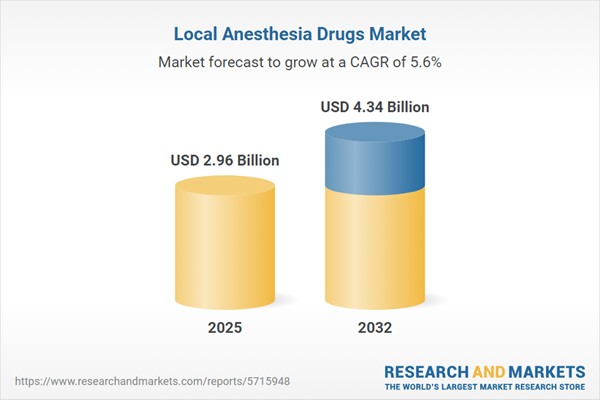Speak directly to the analyst to clarify any post sales queries you may have.
Senior leaders in the local anesthesia drugs market must navigate constant innovation, evolving patient needs, and intricate regulations. Well-informed strategic decisions depend on reliable, actionable intelligence tailored to swiftly adapting care standards and operational demands in healthcare delivery.
Market Snapshot: Local Anesthesia Drugs Market
The local anesthesia drugs market showed a valuation of USD 2.80 billion in 2024, with growth forecasted to USD 2.96 billion by 2025 and USD 4.34 billion by 2032. The sector’s compound annual growth rate (CAGR) stands at 5.64%.
This sustained upward trajectory is propelled by ongoing advances in drug delivery technologies, rising demand for minimally invasive care options, and strengthened supply chain practices. Companies adjust business models by investing in procurement excellence, agile supply networks, and standardized operations to align with market shifts across global and local landscapes.Scope & Segmentation
- Route Administration: Infiltration, nerve blocks, regional anesthesia, spinal injections, and topical therapies support a wide range of care environments, from hospitals and dental practices to outpatient and surgical clinics.
- Drug Class: Amide-based anesthetics include bupivacaine, lidocaine, mepivacaine, prilocaine, and ropivacaine, while ester-based options comprise benzocaine, procaine, and tetracaine, addressing diverse clinical preferences and safety needs.
- Product Type: Creams, gels, sprays, injections, and patches accommodate varied procedural and provider requirements such as those found in hospitals, day surgery centers, and dental offices.
- Formulation: Multi-dose vials, powders, prefilled syringes, and single-dose ampoules streamline workflow and support consistent medication administration within different care delivery settings.
- End-User: Ambulatory surgery centers, dental offices, home healthcare organizations, public hospitals, and private clinics rely on these products to support specialist treatments and high patient throughput.
- Distribution Channel: Hospital and retail pharmacies, as well as digital pharmacy platforms, are utilized to ensure reliable medication access and compliance across healthcare systems.
- Application: Dentistry, dermatology, ENT, ophthalmology, and podiatry use local anesthetics to facilitate both routine and specialist interventions for inpatient and outpatient care.
- Geographical Coverage: Analysis covers North America including the U.S., Canada, and Mexico; South America; EMEA; and Asia-Pacific, such as China, India, Japan, and Southeast Asia—regions defined by compliance demands and specific demographic profiles.
- Key Companies Profiled: Major profiled organizations include Pfizer Inc., Teva Pharmaceutical Industries Ltd., Viatris Inc., Sandoz International GmbH, Fresenius Kabi AG, Hikma Pharmaceuticals PLC, B. Braun Melsungen AG, Aspen Pharmacare Holdings Ltd., Amneal Pharmaceuticals, Inc., and Sun Pharmaceutical Industries Ltd.
Key Takeaways for Senior Leaders
- Liposomal and polymer-based delivery innovations are extending pain management duration and raising safety profiles, supporting advanced procedure needs.
- Longer-acting, targeted anesthetic agents are enabling healthcare systems to expand ambulatory services, driving efficiency outside conventional acute care settings.
- Collaborations among pharmaceutical manufacturers, technology partners, and service providers are accelerating the adoption of improved therapeutics and practice harmonization across care networks.
- Incorporating digital health analytics into anesthesia practice delivers actionable insights, enabling better resource planning and workflow flexibility in clinical settings.
- Organizations are prioritizing up-to-date workforce training and streamlined compliance processes to meet shifting regulatory and supply chain requirements.
Tariff Impact & Supply Chain Outlook
Forthcoming U.S. tariff changes in 2025 are prompting anesthesia drug companies to reevaluate their sourcing, compliance, and inventory systems. Strategic leaders are enhancing domestic supplier alliances, adjusting procurement methods, and adopting more responsive inventory models. Proactive risk monitoring and flexible procurement practices are becoming essential for mitigating supply disruptions and ensuring stability in patient care delivery.
Methodology & Data Sources
The market report draws on a robust blend of secondary research, expert interviews, and comprehensive data triangulation. Applying both top-down and bottom-up analytical approaches, the findings are designed to inform reliable strategies for senior-level executives.
Why This Report Matters
- Enables senior decision-makers to assess evolving medical technologies, support market expansion, and manage compliance more efficiently.
- Clarifies the impact of changing competitive strategies and regulatory frameworks, helping to optimize risk and resource management.
- Guides providers through sector transitions and operational adjustments with practical, timely market intelligence.
Conclusion
This report equips senior leaders in the local anesthesia drugs market with data-driven guidance to inform key decisions, foster adaptability, and maintain high standards for care as the sector changes.
Additional Product Information:
- Purchase of this report includes 1 year online access with quarterly updates.
- This report can be updated on request. Please contact our Customer Experience team using the Ask a Question widget on our website.
Table of Contents
3. Executive Summary
4. Market Overview
7. Cumulative Impact of Artificial Intelligence 2025
Companies Mentioned
The companies profiled in this Local Anesthesia Drugs market report include:- Pfizer Inc.
- Teva Pharmaceutical Industries Ltd.
- Viatris Inc.
- Sandoz International GmbH
- Fresenius Kabi AG
- Hikma Pharmaceuticals PLC
- B. Braun Melsungen AG
- Aspen Pharmacare Holdings Ltd.
- Amneal Pharmaceuticals, Inc.
- Sun Pharmaceutical Industries Ltd.
Table Information
| Report Attribute | Details |
|---|---|
| No. of Pages | 187 |
| Published | October 2025 |
| Forecast Period | 2025 - 2032 |
| Estimated Market Value ( USD | $ 2.96 Billion |
| Forecasted Market Value ( USD | $ 4.34 Billion |
| Compound Annual Growth Rate | 5.6% |
| Regions Covered | Global |
| No. of Companies Mentioned | 11 |









